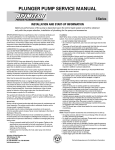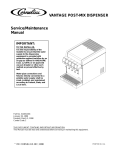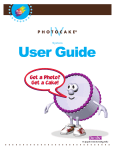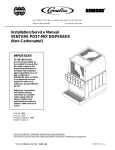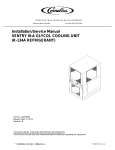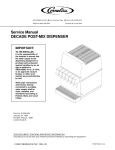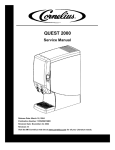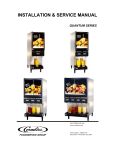Download PLUNGER PUMP SERVICE MANUAL
Transcript
PLUNGER PUMP SERVICE MANUAL 5 Series INSTALLATION AND START-UP INFORMATION Optimum performance of the pump is dependant upon the entire liquid system and will be obtained only with the proper selection, installation of plumbing for the pump and accessories. SPECIFICATIONS: Maximum specifications refer to individual attributes and may have qualifications. It is not implied that any maximums can be performed concurrently. If more then one maximum is considered, check with your Arimitsu Pumps supplier of Arimitsu of N.A. to confirm the proper performance, environment, system design and pump selection. Refer to the respective Product Data Sheet (PDS) for complete specification, parts lists, performance charts and exploded view. LUBRICATION: Fill crankcase with Arimitsu pump oil (p/n 30103) to required level. DO NOT RUN PUMP WITHOUT OIL IN CRANKCASE. Change oil according to the following schedule; after the first 30 hours, then every 500 hours or once per year which ever comes first. Additional lubrication may be required with increased hours of operation, temperature, and various environments. PUMP ROTATION: Pump was designed for forward rotation, unless otherwise noted by a directional arrow. If rotating counter to arrow, additional oil should be added to aid lubrication. Fill to slightly above the upper line on dipstick to assure adequate lubrication. PULLEY SELECTION: Select size of motor pulley required to deliver the desired flow. Be careful to choose a pulley with the proper horsepower capacity. Horsepower requirement can be found on PDS for each respective model. Use formula found on formulas page as a guide to pulley selection. Note: Use the same pitch size pulleys for both pump and motor. DRIVE SELECTION: The motor or engine driving the pump must be of sufficient horsepower to maintain full RPM when the pump is at the desired load. Select the electric motor from the Horsepower chart according to required pump discharge flow, maximum pressure at the pump and drive losses of approximately 5%. Consult the manufacturer of gas or diesel engine for selection of the proper engine size. Use formula found on formulas page as a guide for HP calculation. The quotient will indicate the minimum HP size of motor to select. Please choose a HP size larger when possible to allow for system inefficiencies such as line loss and plumbing irregularities. MOUNTING: Choose a level horizontal surface that will allow access for maintenance and visual inspection. The surface must be able to withstand vibration and be strong enough to support the pump. Use flexible hose for inlet and discharge connections on the pump to minimize possible system stresses. Never connect rigid pipe to the inlet of discharge of the pump. Make sure the pump crankshaft and motor crankshaft are parallel and mounted pulleys are in the straight line. Misalignment will lead to a loss of performance and premature belt failure, in addition to damaging the pump and/or motor. • Choose a properly-rated belt for the HP of the system. Tighten to the specifications recommended by the belt manufacturer. Do not over tighten. Hand rotate pump pulley prior to starting to verify shaft and bearings are free moving. • Protect pump from humidity, dirt, heat, water spray and chemical exposure. Arimitsu of North America, Inc. 700 McKinley St. NW Anoka, MN 55303 ph: 763.433.0303 • fax: 763.433.0404 arimitsupumps.com PLUMBING: INLET: When done correctly, inlet plumbing will positively benefit the system. If you have any questions, please contact Arimitsu Pumps. • DO NOT STARVE PUMP OR RUN DRY • As a minimum requirement, use a hose one size larger than the inlet port size. • The pump will work best with a pressurized inlet that does not exceed the maximum recommended on the specification sheet. • Every pump is designed for suction lift (vacuum) inlet conditions, however optimum performance is obtained with a pressurized inlet. In cases such as hot or thick liquids, or high speed a positive inlet is recommended. • Several long-term failures result from improperly plumbed inlet systems such as, valve breakage, manifold washout, seal failure, noise, vibration, and plunger pitting. • Pumps are not designed to run dry. • Temperatures above 120°F are permissible. Add 1 PSI inlet pressure per each degree F over 120°F. Elastomer or RPM changes may be required in addition to pressure adjustment. DISCHARGE: The fluid must have a place to go. All pumps MUST have hydraulic flow control devices. • Install a properly sized and functioning flow control device such as an unloader valve or pressure regulator that will allow pumped fluid to be diverted in case nozzles become plugged or trigger is disengaged. • Do not use metering valves or ball valves as primary flow control devices. • DO NOT use a regulating device with selectable pressure greater than pump rating. • Open all valves prior to starting system to avoid deadhead overpressure condition and severe damage to the pump or system. • Install a pulsation dampener, pulse hose or accumulator, on the discharge head or in the discharge line as close to the head as possible. Be certain the pulsation dampener is properly sized for the system pressure and flow. • A reliable pressure gauge should be installed near the discharge outlet of the high-pressure manifold. This is extremely important for adjusting pressure regulating devices and also for proper sizing of the nozzle or restricting orifice. The pump is rated for a maximum pressure; this is the pressure at the discharge manifold of the pump, not anywhere else in the pressure line. • Use PTFE thread tape or pipe thread sealant to connect accessories or plumbing. MAINTENANCE: Check: Inspect all system accessories and connections prior to start-up. • Oil quality and level. Add oil if it is low and change if the oil looks old or milky. (Arimitsu Oil p/n 30103) • For leaks from manifold and crankcase. Change seals as necessary or according to scheduled service intervals. • Clean inlet filter or strainer as needed. • Verify nozzles are not worn or damages. Nozzles create the pressure, so a worn nozzle will result in lower performance. Worn or damaged hoses must be replaced before use. • Verify unloaders/regulators are adjustable and appear in good condition. • Inspect hoses and connections for damage. • Inspect belts for signs of wear or damage. • Inspect trigger guns and other control valves. Visit arimitsupumps.com for distributor information SERVICING THE FLUID END Seal Service follow steps 1 – 3, & 7 - 19 1. Loosen (do not remove) outer bolts (6mm) of Manifold Assembly. These 8 bolts will be removed later for valve inspection. Remove center 4 bolts (6mm). 2. Gently pull Manifold Assembly away from crankcase. Be careful to pull straight to avoid damaging Plungers. Rotation of Crankshaft may aid in separating Manifold Assembly from Crankcase Assembly. 3. Lay Manifold Assembly on work surface and remove 8 outer bolts. Manifold Assembly should separate easily to allow access to Valve Assemblies. Inspect Manifold O-Rings for damage and replace if necessary. [Note: For Valve Service continue to Step 4, for Seal Service skip to Step 7.] 4. Inlet Valves are larger than Outlet Valves for 508 & 511. Model 516 Valves are the same. Grasp Valve Cage with pliers and gently rock and pivot until Valve comes free. 5. Examine Valves for damage such as pitting, gouging, or broken parts. If damaged, replace with parts referenced in the kit reference chart on page 3. 6. Install Valve Assemblies according to type and hole size. Valve Gasket can be fit around and pushed after Valve Assembly has been installed. Be careful not to roll Valve Gasket edge over during installation. Valve Gasket should be flat without bulges around Valve Seat. 7. Examine Plungers for cracks or surface damage. Replace Plunger and Gasket if damaged as follows: a. Remove Plunger Bolt (mm), Gasket and Plunger Support. b. Inspect and clean Support. c. Place new Gasket on Plunger Bolt, then New Plunger, and finally Support. Note: Support end of Plunger has an identifying mark or dot. d. Install assembly into Connecting Rod end and torque to 5 ft. lbs. [Note; For Seal Service continue with Step 8. To complete Valve service skip to Step 13.] 8. Remove Seal Retainer, V packing, Spreader and Wave Washer from ported manifold. Inserting a plastic driver in the wave washer area may aid the process. Inspect seal bore for damage and clean if necessary. 9. The Vacuum Seal can be removed from the inside of Seal Retainer with a plastic driver, to avoid scratching surface. Inspect for damage. Complete Seal Service with parts referenced in the kit reference chart on page 3. (model 508 & 511) (model 516) Valve Service follow steps 1 – 7, & 13 - 19 10.Insert Wave Washer, Spreader, V packing, (and back-up ring for Model 516) into Seal Chamber of manifold. The Vacuum Seal can be installed by squeezing and fitting into inside groove of Seal Retainer. Be sure to install Vacuum Seal with “u” of seal facing towards V packing. 11.Replace O-Ring (included in Seal Kit) around outside of Seal Retainer. 12.Lightly lubricate seal bore and insert Seal Retainer. Even force will allow Seal Retainer to slide into position. 13.Place Manifolds together. Manifold Dowel Pins will guide the 2 Manifolds together. Note: To insure Manifold O-Ring remains in position during servicing, re-install and hold in place with grease. 16.Replace center 4 bolts and torque to specifications listed in torque chart below. Note: Bolts should be tightened following the standard practice of an X pattern around Manifold Assembly. 17.After the center 4 bolts are torqued, tighten 8 outer bolts to torque to specifications listed in torque chart below. Use standard practice of X pattern for these bolts as well. 18.Crankshaft should turn with minimal effort by hand when service is complete. Check/add crankcase oil to proper level on dipstick before operation. Arimitsu oil (PN30103). KIT REFERENCE CHART 14.Replace 8 outer bolts and tighten finger tight. Pump Model Inlet Kit Outlet Kit Seal Kit 15.Lightly lubricate Plungers and carefully slide Manifold Assembly over Plungers until it contacts Crankcase Assembly. 508 511 516 30111 30111 30101 30112 30112 30101 30110 30120 30100 TORQUE CHART Pump Item Thread Tool Size (P/N) in lbs 3 Series Valve Plug 22mm 24mm Hex 475 Torque ft. lbs. Nm 53.9 24.5 10.8 6.9 Manifold Bolts Connecting Rod Plunger Retainer 8mm 6mm 5mm 6mm Allen 10mm Hex 4mm Allen 215 95 60 40 18 8 5 5 Series Manifold Bolts Connecting Rod Plunger Retainer 8mm 6mm 5mm 6mm Allen 10mm Hex 4mm Allen 215 95 60 18 8 5 24.5 10.8 6.9 7 Series Outer Manifold Bolts Inner Manifold Bolts Connecting Rod Plunger Retainer 8mm 10mm 6mm 5mm 6mm Allen 8mm Allen 10mm Hex 4mm Allen 215 475 95 60 18 40 8 5 24.5 53.9 10.8 6.9 11 Series Manifold Nuts Connecting Rod Plunger Retainer 12mm 8mm 5mm 19mm Hex 13mm Hex 4mm Allen 695 215 60 55 18 5 78.5 24.5 6.9 INLET CONDITION CHECK-LIST INLET PRESSURE should fall within the specifications of the pump. o Optimum pump performance is obtained with +15 PSI (1 BAR) inlet pressure. o With adequate inlet plumbing, most pumps will perform with flooded suction. Maximum inlet pressure is 75 PSI (5 BAR). o After prolonged storage, pump should be rotated by hand and purged of air to facilitate priming. o Disconnect the discharge port and allow liquid to pass through pump and measure flow. INLET ACCESSORIES are offered to protect against over pressurization, contamination or temperature and control flow. o A shut-off valve is recommended to facilitate maintenance. o Inspect and clean inlet filters on a regular schedule to avoid flow restriction. o All accessories should be sized to avoid restricting the inlet flow. o All accessories should be compatible with the solution being pumped to prevent premature failure or malfunction. o A gauge between filter and pump will indicate pump inlet pressure. Avoid negative pressure (vacuum) inlet conditions. BY-PASS TO INLET Care should be exercised when deciding the method of by-pass from control valves. o It is recommended the bypass be directed to a baffled reservoir tank, as described above. o Although not recommended, bypass liquid may be returned to the inlet line of the pump. With a pressurized inlet system only, a thermo relief valve should be used in the by-pass line to monitor the temperature build-up in the by-pass loop to avoid premature seal failure. o A reinforced flexible, low-pressure hose rated up to 300 PSI should be used for bypass flow back to inlet. o Caution should be exercised not to under size the bypass hose diameter and length. o Check the pressure in the bypass line to avoid over pressurizing the inlet. o The by-pass should be connected to the pump inlet line with a constant downward slope. INLET SUPPLY should exceed the maximum flow being delivered by the pump to assure proper performance. o Open inlet shut-off valve and turn on water supply to avoid starving pump. DO NOT RUN PUMP DRY. o Temperatures above 120°F are permissible. Add 1 PSI inlet pressure per each degree F over 120°F. Seal material or RPM changes may be required. o Avoid closed loop systems especially with high temperature fluid or large flows. The type of unloader or regulator can vary the effects of closed loop bypass. o Higher viscosity, thicker liquids require a positive head (0+ PSI) and RPM changes may be required. Horsepower requirements may increase. o When using a supply tank, size it to provide an adequate supply of water and enough volume to decrease turbulence created from bypass return stream. Generally, a minimum of 5 times the GPM although several system factors can affect this. Provide adequate baffling in the tank to eliminate air bubbles and turbulence; install diffusers on all return lines to the tank. Do not locate supply ports next to bypass return ports. o Supply tanks should be located above pump inlet with inlet lines plumbed from the bottom of the tank. o Tank fed, suction systems should have a constant downward slope into pump inlet. o Make sure adequate filtration exists to prevent debris from damaging pump. INLET SIZE should be adequate to avoid starving the pump. o Line size must be a minimum of one common size larger than the pump inlet fitting. Avoid tees, 90-degree elbows or valves in the inlet line of the pump to reduce the risk of flow restriction and cavitation. o The line must be a FLEXIBLE reinforced hose, NOT a rigid pipe. Soft hose can decrease system vibration. o All systems should use a minimum of fittings and turns. o Use an approved pipe sealant or tape to assure airtight, positive sealing of all connections. MAINTENANCE AND SERVICE TIPS PREVENTATIVE MAINTENANCE CHECK-LIST Check Daily Weekly 50 hrs. Clean Filters 500 hrs.* 1500 hrs.** 3000 hrs.** X Oil Level/Quality X Oil Leaks X Water Leaks X Belts/Pulley X Plumbing X Initial Oil Change SERVICE TIPS: • When pumping harsh chemicals, flush out chemical residue immediately after use. Do not leave chemicals inside pump. If it is not water or anti-freeze, flush from pump before storage. • If the pump is used in areas or times of freezing, pump it dry or leave anti-freeze in at time of storage. • Use case and maintenance to prolong the life of the equipment. X Oil Change X Seal Change X Valve Change Accessories SERVICE INTERVALS: • Change Oil (PN30103) every 500 hours. • Change high-pressure and low-pressure seals every 1500 hours. • Change valves every 3000 hours. X X * If other than Arimitsu oil is used, change cycle would be every 300 hours **Each system’s maintenance cycle will be exclusive. If system performance decreases, check immediately. If no wear at 1500 hours, check again at 2000 hours and each 500 until wear is observed. Valves typically require changing every other seal change. Duty cycle, temperature, quality of pumped liquid and inlet feed conditions all effect the life of pump wear part and service cycle. **Remember to service the regulator/unloader at each seal servicing and check all system accessories and connections before resuming operation. HELPFUL FORMULAS AND REFERENCE CHARTS Determining Pump RPM Rated GPM = Rated RPM Determining Required HP GPM x PSI Motor Pulley OD = Pump RPM HOSE FRICTION LOSS “Desired” RPM Electric Brake H.P. Required = 1460 Determining Motor Pulley Size “Desired” GPM Pump Pulley OD Motor RPM RESISTANCE OF VALVES AND FITTINGS Equivalent Length of Standard Pipe in Feet Nominal Pipe Inside Size Diameter Gate Globe Angle 45˚ 90˚ Inches Inches Valve Valve Valve Elbow Elbow 180˚ Close Ret Tee Tee Thru Thru Run Branch 1/2 3/4 1 1-1/4 1-1/2 0.622 0.824 1.049 1.380 1.610 0.41 0.54 0.69 0.90 1.05 18.5 24.5 31.2 41.0 48.0 9.3 12.3 15.6 20.5 24.0 0.78 1.03 1.31 1.73 2.15 1.67 2.21 2.81 3.70 4.31 3.71 4.90 6.25 8.22 9.59 0.93 1.23 1.56 2.06 2.4 2 2-1/2 3 4 2.067 2.469 3.068 4.026 1.35 1.62 2.01 2.64 61.5 73.5 91.5 120.0 30.8 36.8 45.8 60.0 2.59 3.09 3.84 5.03 5.55 6.61 8.23 10.80 12.30 14.70 18.20 23.90 3.08 11.6 3.68 13.20 4.57 16.40 6.00 21.6 3.33 4.41 5.62 7.40 8.63 Arriving at a total line pressure loss, consideration should then be given to pressure loss created by valves, fitting and elevation of lines. If a sufficient number of valve and fitting are incorporated in the system to materially affect the total line loss, add to the total line length, the equivalent length of line of each valve or fitting. PRESSURE DROP IN PSI PER 100 FT OF HOSE WITH TYPICAL WATER FLOW RATES Water Hose inside diameters, inches Flow 1/4 5/16 3/8 1/2 5/8 3/4 GPM 1” 1 2 3 7 12 19 24 42 62 93 0.5 16 5 2 1 54 20 7 2 2 180 60 25 6 2 3 380 120 50 13 4 4 220 90 24 7 5 320 130 34 10 6 220 52 16 8 300 80 25 10 450 120 38 15 900 250 80 20 1600 400 121 25 650 200 30 250 40 410 50 600 60 NOZZLE FORMULAS Nozzle# = GPM x 4000 PSI x PSI 4000 x 4000 GPM = Nozzle # ( GPM Nozzle PSI = ) 2 SPRAY ANGLE SPRAY ANGLE Orifice Dia. 100 PSI 500 PSI 800 PSI 1000 PSI 1200 PSI 1500 PSI 2000 PSI 4000 PSI 2.00 2 .034 .32 .71 .89 1.00 1.10 1.22 1.41 2.5 .039 .40 .88 1.12 1.25 1.37 1.53 1.77 2.50 3 .043 .47 1.06 1.34 1.50 1.67 1.84 2.12 3.00 3.5 .048 .55 1.24 1.57 1.75 1.92 2.14 2.47 3.50 4 .052 .63 1.41 1.79 2.00 2.19 2.45 2.83 4.00 4.5 .055 .71 1.59 2.01 2.25 2.46 2.76 3.18 4.50 5.00 5 .057 .79 1.77 2.24 2.50 2.74 3.06 3.54 5.5 0.60 .87 1.94 2.46 2.75 3.01 3.37 3.89 5.50 6 .062 .95 2.12 2.68 3.00 3.29 3.67 4.24 6.00 6.5 .064 1.03 2.30 2.91 3.25 3.56 3.98 4.60 6.50 7 .067 1.11 2.47 3.13 3.50 3.83 4.29 4.95 7.00 7.5 .070 1.19 2.65 3.35 3.75 4.11 4.59 5.30 7.50 8 .072 1.26 2.83 3.58 4.00 4.38 4.90 5.66 8.00 8.5 0.74 1.34 3.01 3.80 4.25 4.66 5.21 6.01 8.50 9 .076 1.42 3.18 4.02 4.50 4.93 5.51 6.36 9.00 9.5 0.78 1.50 3.36 4.25 4.75 5.20 5.82 6.72 9.50 10 0.80 1.58 3.54 4.47 5.00 5.48 3.12 7.07 10.00 11 0.83 1.74 3.89 4.92 5.50 6.02 6.74 7.78 11.00 12 0.87 1.90 4.24 5.37 6.00 6.57 7.35 8.49 12.00 12.5 .089 1.98 4.42 5.59 6.25 6.85 7.65 8.84 12.5 .091 2.06 4.60 5.81 6.50 7.12 7.96 9.19 13.00 13 14 .093 2.21 4.95 6.26 7.00 7.67 8.57 9.90 14.00 15 .096 2.37 5.30 6.71 7.50 8.22 9.19 10.61 15.00 20 .109 3.16 7.07 8.94 10.00 10.95 12.25 14.14 20.00 25 .125 3.95 8.84 11.18 12.50 13.69 15.31 17.68 25.00 30 .141 4.74 10.61 13.42 15.00 16.43 18.37 21.12 30.00 40 .156 6.32 14.14 17.89 20.00 21.91 24.49 28.28 40.00 50 .172 7.91 17.68 22.36 25.00 27.39 30.62 35.36 50.00 60 .188 9.49 21.21 28.83 30.00 32.86 36.74 42.43 60.00 SPRAY DISTANCE THEORETICAL COVERAGE NOZZLE VOLUME (GPM) AT VARIOUS PRESSURES (PSI) Nozzle Size 2 3 4 7 10 14 30 50 76 96 162 235 370 NOZZLE COVERAGE CHART THEORETICAL COVERAGE AT VARIOUS DISTANCES Included FROM NOZZLE ORIFICE Spray 2” 4” 6” 8” 10” 12” 15” 18” 24” Angle 5˚ 10˚ 15˚ 20˚ 25˚ 30˚ 35˚ 40˚ 45˚ 50˚ 55˚ 60˚ 65˚ 70˚ 75˚ 80˚ 85˚ 90˚ 95˚ 100˚ 110˚ 120˚ 130˚ 140˚ 150˚ 160˚ 170˚ 0.2 0.4 0.5 0.7 0.9 1.1 1.3 1.5 1.7 1.9 2.1 2.3 2.5 2.8 3.1 3.4 3.7 4.0 4.4 4.8 5.7 6.9 8.6 10.9 14.9 22.7 45.8 0.4 0.7 1.1 1.4 1.8 2.1 2.5 2.9 3.3 3.7 4.2 4.6 5.1 5.6 6.1 6.7 7.3 8.0 8.7 9.5 11.4 13.9 17.2 21.9 29.8 45.4 91.6 0.5 1.1 1.6 2.1 2.7 3.2 3.8 4.4 5.0 5.6 6.3 6.9 7.6 8.4 9.2 10.1 11.0 12.0 13.1 14.3 17.1 20.8 25.7 32.9 44.7 68.0 0.7 1.4 2.1 2.8 3.5 4.3 5.0 5.8 6.6 7.5 8.3 9.2 10.2 11.2 12.3 13.4 14.7 16.0 17.5 19.1 22.8 27.7 34.3 43.8 59.6 90.6 0.9 1.8 2.6 3.5 4.4 6.4 6.3 7.3 8.3 9.3 10.3 11.5 12.7 14.0 15.3 16.8 18.3 20.0 21.8 23.8 28.5 34.6 42.9 54.8 74.5 113 1.1 2.1 3.2 4.2 5.3 5.4 7.6 8.7 9.9 11.2 12.5 13.8 15.3 16.8 18.4 20.2 22.0 24.0 26.2 28.6 34.3 41.6 51.5 65.7 89.5 1.3 1.6 2.6 3.1 3.9 4.7 5.3 6.4 6.6 8.0 8.1 9.7 9.5 11.3 10.9 13.1 12.4 14.9 14.0 16.8 15.6 18.7 17.3 20.6 19.2 22.9 21.0 25.2 23.0 27.6 25.2 30.3 27.5 33.0 30.0 36.0 32.8 39.3 35.8 43.0 42.8 51.4 52.0 62.4 64.4 77.3 82.2 98.6 112 2.1 4.2 6.3 8.5 10.6 12.8 15.5 17.5 19.9 22.4 25.0 27.7 30.5 33.6 36.8 40.3 44.0 48.0 52.4 57.2 68.5 83.2 103 DIAGNOSIS AND MAINTENANCE Several elements make up a complete, functioning pumping system. All of these elements need to be operating correctly in order for the whole system to function. Some of the elements include: duty-cycle, liquid being pumped, operating conditions and specifications versus the ratings and capabilities of the pump and accessories. Proper care and maintenance of pump and system components will maximize the life of your equipment. Review and follow recommendations regarding system design and inlet conditions to avoid potential problems. Arimitsu Pumps are designed to offer superior life and be easy to service. Field servicing can be accomplished with standard tools. Use the following table as a guide to determine cause and remedy for possible problems. Contact Arimitsu Pumps directly via web site or telephone for further assistance. PROBLEM PROBABLE CAUSE SOLUTION Low pressure Pulsation Water leak •Under the manifold •Into the crankcase Knocking noise •Inlet supply •Pulley • Worn nozzle. • Belt slippage. • Air leak in inlet plumbing. • Pressure gauge inoperative or not registering accurately. • Relief valve stuck, partially plugged or improperly adjusted. • Inlet suction strainer (filter) clogged or improperly sized. • Abrasives in pumped liquid. • Leaky discharge hose or spray gun. • Inadequate liquid supply. • Severe cavitation. • Worn Seals. • Worn or dirty inlet/discharge valves. • Faulty Pulsation Dampener. • Foreign material trapped in inlet/discharge valves. • Worn V-Packings, Hi-Pressure or Lo-Pressure Seals. • Humid air condensing into water inside the crankcase. • Excessive wear to seals and V-Packings. • Inadequate inlet liquid supply. • Loose pulley on crankshaft Oil leak •Crankcase oil seals •Crankshaft oil seals and o-rings •Drain plug •Rear cover •Filler cap Pump runs extremely rough •Inlet conditions •Pump valves •Pump seals Premature seal failure Recommended Oil Service Intervals: After first 30 hours, every 500 hours thereafter. • Worn crankcase oil seals. • Replace crankcase oil seals. • Worn crankshaft oil seals or o-rings on bearing cover. • Remove bearing cover and replace o-rings and/or oil seals. • Loose drain plug or worn drain plug o-ring. • Tighten drain plug or replace o-ring. • Loose rear cover or worn rear cover gasket. • Tighten rear cover or replace gasket. • Excessive oil in crankcase. • Fill crankcase to specified capacity, do not overfill. • Restricted inlet or air entering the inlet plumbing. • Correct inlet size plumbing. Check for loose connections. Clean filters. • Stuck inlet/discharge valves. • Clean out foreign material or install new valve kit. • Leaking V-Packings, Hi-Pressure or Lo-Pressure seals. • Install new seal kit. Increase frequency of service. • Scored plungers. • Replace plungers, check inlet conditions. • Over pressure to inlet manifold. • Reduce inlet pressure per specifications. • Abrasive material in the liquid being pumped. • Install proper filtration at pump inlet and clean regularly. • Excessive pressure and/or temperature of pumped liquid. • Check pressure and inlet liquid temperature. • Running pump dry. • DO NOT RUN PUMP WITHOUT LIQUID. • Starving pump of adequate liquid. • Increase hose one size larger than inlet port size. Pressurize and dual feed. • Replace with properly sized nozzle. • Tighten belt(s) or install new belt(s). • Tighten fittings and hoses. Use PTFE liquid or tape. • Check with new gauge. Replace worn or damaged gauge. • Clean/adjust relief valve. Replace worn seats/valves and o-rings. • Clean filter. Use adequate size filter. Check more frequently. • Install proper filter. • Replace discharge hose with proper rating for system. • Check & clean filters. • Check inlet conditions. • Install new seal kit. Increase frequency of service. • Clean inlet/discharge valves or install new valve kit. • Check precharge. If low, recharge, or install new dampener or pulse hose. • Clean inlet/discharge valves or install new valve kit. • Install new seal kit. Increase frequency of service. • Change oil every 3 months or 500 hours. • Install new seal kit. Increase frequency of service. Check inlet & water conditions • Check liquid supply. Increase line size, pressurize, or dual feed. • Check key and tighten set screw.






